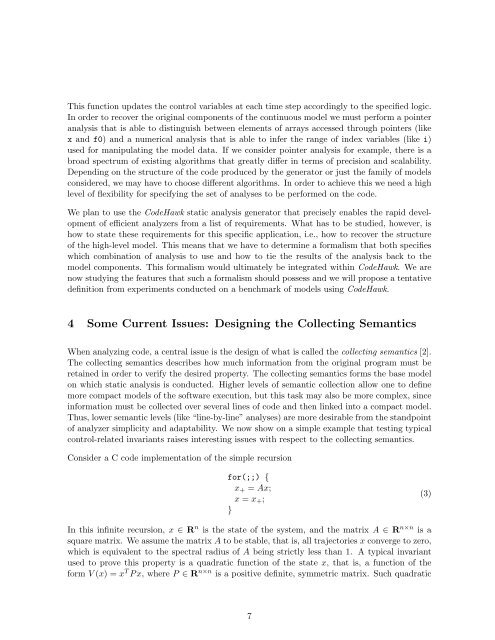Static Stability Analysis of Embedded, Autocoded Software
Static Stability Analysis of Embedded, Autocoded Software
Static Stability Analysis of Embedded, Autocoded Software
You also want an ePaper? Increase the reach of your titles
YUMPU automatically turns print PDFs into web optimized ePapers that Google loves.
This function updates the control variables at each time step accordingly to the specified logic.In order to recover the original components <strong>of</strong> the continuous model we must perform a pointeranalysis that is able to distinguish between elements <strong>of</strong> arrays accessed through pointers (likex and f0) and a numerical analysis that is able to infer the range <strong>of</strong> index variables (like i)used for manipulating the model data. If we consider pointer analysis for example, there is abroad spectrum <strong>of</strong> existing algorithms that greatly differ in terms <strong>of</strong> precision and scalability.Depending on the structure <strong>of</strong> the code produced by the generator or just the family <strong>of</strong> modelsconsidered, we may have to choose different algorithms. In order to achieve this we need a highlevel <strong>of</strong> flexibility for specifying the set <strong>of</strong> analyses to be performed on the code.We plan to use the CodeHawk static analysis generator that precisely enables the rapid development<strong>of</strong> efficient analyzers from a list <strong>of</strong> requirements. What has to be studied, however, ishow to state these requirements for this specific application, i.e., how to recover the structure<strong>of</strong> the high-level model. This means that we have to determine a formalism that both specifieswhich combination <strong>of</strong> analysis to use and how to tie the results <strong>of</strong> the analysis back to themodel components. This formalism would ultimately be integrated within CodeHawk. We arenow studying the features that such a formalism should possess and we will propose a tentativedefinition from experiments conducted on a benchmark <strong>of</strong> models using CodeHawk.4 Some Current Issues: Designing the Collecting SemanticsWhen analyzing code, a central issue is the design <strong>of</strong> what is called the collecting semantics [2].The collecting semantics describes how much information from the original program must beretained in order to verify the desired property. The collecting semantics forms the base modelon which static analysis is conducted. Higher levels <strong>of</strong> semantic collection allow one to definemore compact models <strong>of</strong> the s<strong>of</strong>tware execution, but this task may also be more complex, sinceinformation must be collected over several lines <strong>of</strong> code and then linked into a compact model.Thus, lower semantic levels (like “line-by-line” analyses) are more desirable from the standpoint<strong>of</strong> analyzer simplicity and adaptability. We now show on a simple example that testing typicalcontrol-related invariants raises interesting issues with respect to the collecting semantics.Consider a C code implementation <strong>of</strong> the simple recursionfor(;;) {x + = Ax;x = x + ;}(3)In this infinite recursion, x ∈ R n is the state <strong>of</strong> the system, and the matrix A ∈ R n×n is asquare matrix. We assume the matrix A to be stable, that is, all trajectories x converge to zero,which is equivalent to the spectral radius <strong>of</strong> A being strictly less than 1. A typical invariantused to prove this property is a quadratic function <strong>of</strong> the state x, that is, a function <strong>of</strong> theform V (x) = x T P x, where P ∈ R n×n is a positive definite, symmetric matrix. Such quadratic7
















